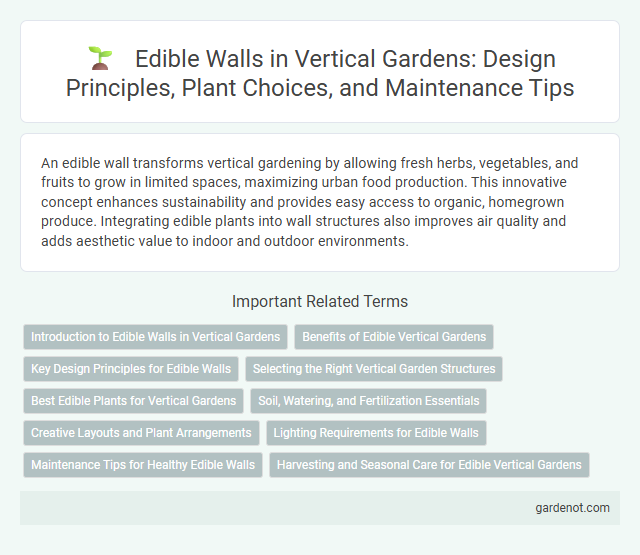An edible wall transforms vertical gardening by allowing fresh herbs, vegetables, and fruits to grow in limited spaces, maximizing urban food production. This innovative concept enhances sustainability and provides easy access to organic, homegrown produce. Integrating edible plants into wall structures also improves air quality and adds aesthetic value to indoor and outdoor environments.
Introduction to Edible Walls in Vertical Gardens
Edible walls in vertical gardens transform limited spaces into productive areas by growing herbs, vegetables, and fruits on vertical surfaces. These green installations maximize urban gardening potential, offering fresh, homegrown produce while enhancing air quality and aesthetic appeal. Innovative irrigation systems and soil-free planting techniques ensure healthy growth and easy maintenance in confined environments.
Benefits of Edible Vertical Gardens
Edible vertical gardens maximize urban space by allowing the cultivation of fresh herbs, vegetables, and fruits in small areas, promoting sustainable living. They improve air quality and reduce carbon footprints while providing easy access to nutritious, pesticide-free produce. These gardens also enhance aesthetic appeal and contribute to mental well-being through increased greenery at eye level.
Key Design Principles for Edible Walls
Key design principles for edible walls include selecting plants with compatible water and light requirements to ensure uniform growth and health. Incorporating a robust irrigation system with proper drainage prevents waterlogging and supports root development. Structural support materials must be durable yet lightweight, allowing easy maintenance and maximizing vertical space efficiency.
Selecting the Right Vertical Garden Structures
Choosing the right vertical garden structures for an edible wall involves prioritizing materials that support optimal plant growth and durability, such as galvanized steel, wood, or sturdy plastic modules. Consider modular systems with built-in irrigation to ensure consistent moisture levels for edible plants like herbs, lettuce, and strawberries. Weight capacity, sunlight exposure, and proper drainage play critical roles in maintaining plant health and maximizing harvest yields in vertical garden setups.
Best Edible Plants for Vertical Gardens
Strawberries, cherry tomatoes, and herbs like basil and mint thrive as the best edible plants for vertical gardens due to their compact growth and high yield. Leafy greens such as spinach, kale, and arugula adapt well to vertical structures, providing fresh, nutritious harvests. Peppers and edible flowers like nasturtiums also enhance vertical gardens, combining flavor with visual appeal.
Soil, Watering, and Fertilization Essentials
Edible walls thrive with nutrient-rich, well-draining soil that supports root health and plant growth. Consistent, automated watering systems ensure moisture levels remain optimal, preventing both drought stress and waterlogging. Regular application of organic, balanced fertilizers promotes continuous yield and robust plant development in vertical gardens.
Creative Layouts and Plant Arrangements
Edible walls showcase innovative vertical gardening through creative layouts that maximize space and aesthetic appeal while promoting sustainability. Strategic plant arrangements combine herbs, vegetables, and fruits to optimize sunlight exposure and growth conditions in confined areas. These living installations transform urban environments into productive green spaces, enhancing air quality and providing fresh, homegrown produce.
Lighting Requirements for Edible Walls
Edible walls require balanced lighting conditions to ensure optimal growth and nutrient production of plants. Natural sunlight combined with supplemental LED grow lights offering a full spectrum of wavelengths promotes photosynthesis and enhances flavor development. Light intensity of 200-400 umol/m2/s for 10-14 hours daily supports healthy edible plants like herbs, leafy greens, and small fruits.
Maintenance Tips for Healthy Edible Walls
Regular watering tailored to the specific plant species in an edible vertical garden ensures optimal growth and prevents root rot. Incorporating organic fertilizers rich in nitrogen and phosphorus supports nutrient absorption and promotes lush, flavorful produce. Periodic pruning and removal of diseased leaves helps maintain airflow and reduces the risk of pests, ensuring a vibrant and productive edible wall.
Harvesting and Seasonal Care for Edible Vertical Gardens
Harvesting edible vertical gardens requires knowledge of each plant's growth cycle to ensure peak flavor and nutritional value, with herbs typically ready for trimming every 3-4 weeks. Seasonal care involves adjusting watering schedules according to temperature fluctuations and providing supplemental nutrients during growth peaks, especially in spring and summer. Protecting plants from pests and pruning older leaves promotes healthy regrowth and maximizes yields throughout the year.
Edible wall Infographic

 gardenot.com
gardenot.com